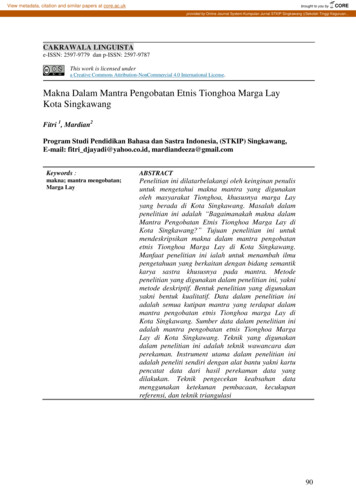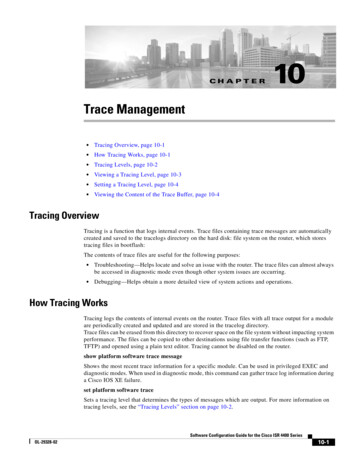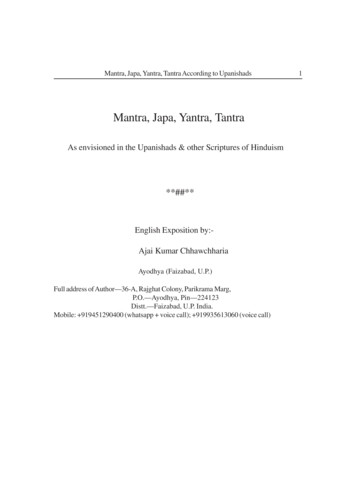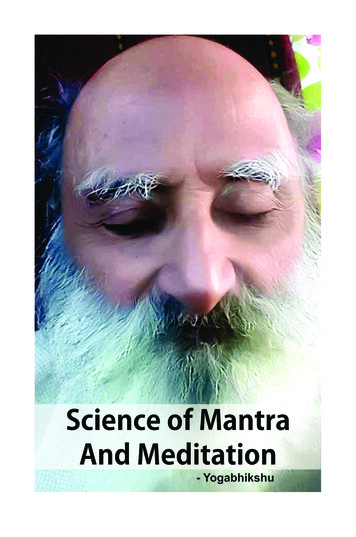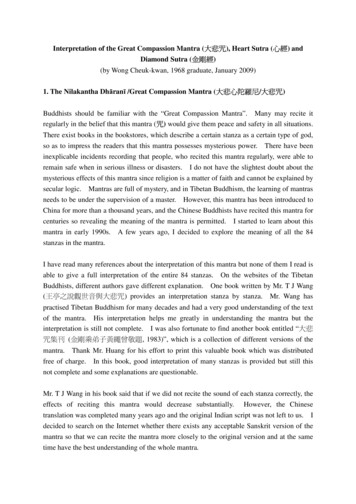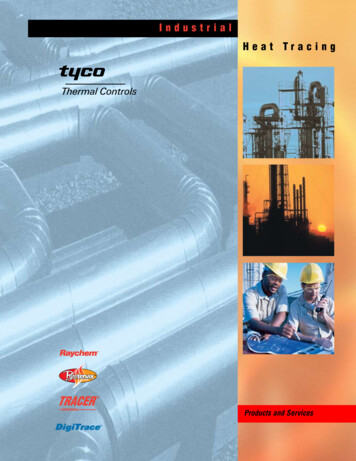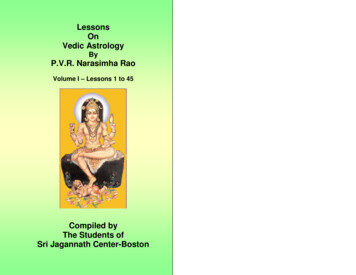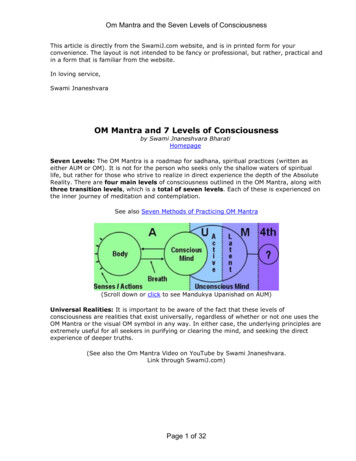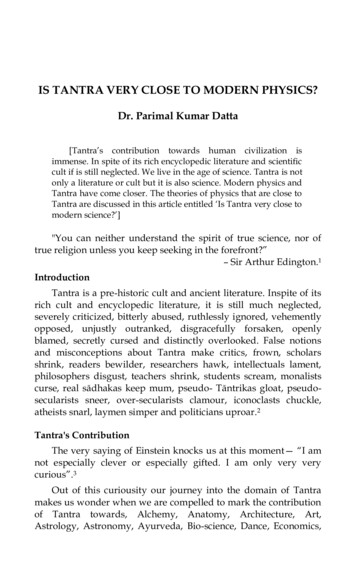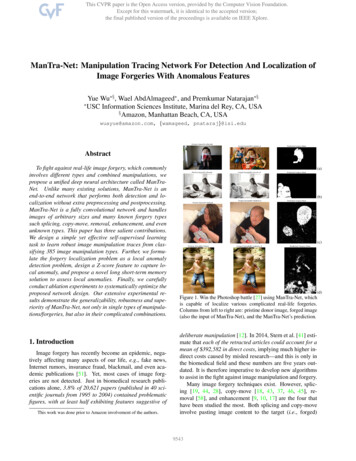
Transcription
ManTra-Net: Manipulation Tracing Network For Detection And Localization ofImage Forgeries With Anomalous Features Yue Wu § , Wael AbdAlmageed , and Premkumar Natarajan §USC Information Sciences Institute, Marina del Rey, CA, USA§Amazon, Manhattan Beach, CA, USAwuayue@amazon.com, {wamageed, pnataraj}@isi.eduAbstractTo fight against real-life image forgery, which commonlyinvolves different types and combined manipulations, wepropose a unified deep neural architecture called ManTraNet. Unlike many existing solutions, ManTra-Net is anend-to-end network that performs both detection and localization without extra preprocessing and postprocessing.ManTra-Net is a fully convolutional network and handlesimages of arbitrary sizes and many known forgery typessuch splicing, copy-move, removal, enhancement, and evenunknown types. This paper has three salient contributions.We design a simple yet effective self-supervised learningtask to learn robust image manipulation traces from classifying 385 image manipulation types. Further, we formulate the forgery localization problem as a local anomalydetection problem, design a Z-score feature to capture local anomaly, and propose a novel long short-term memorysolution to assess local anomalies. Finally, we carefullyconduct ablation experiments to systematically optimize theproposed network design. Our extensive experimental results demonstrate the generalizability, robustness and superiority of ManTra-Net, not only in single types of manipulations/forgeries, but also in their complicated combinations.1. IntroductionImage forgery has recently become an epidemic, negatively affecting many aspects of our life, e.g., fake news,Internet rumors, insurance fraud, blackmail, and even academic publications [51]. Yet, most cases of image forgeries are not detected. Just in biomedical research publications alone, 3.8% of 20,621 papers (published in 40 scientific journals from 1995 to 2004) contained problematicfigures, with at least half exhibiting features suggestive ofThis work was done prior to Amazon involvement of the authors.(a)(b)(c)(d)Figure 1. Win the Photoshop battle [27] using ManTra-Net, whichis capable of localize various complicated real-life forgeries.Columns from left to right are: pristine donor image, forged image(also the input of ManTra-Net), and the ManTra-Net’s prediction.deliberate manipulation [12]. In 2014, Stern et al. [41] estimate that each of the retracted articles could account for amean of 392,582 in direct costs, implying much higher indirect costs caused by misled research—and this is only inthe biomedical field and these numbers are five years outdated. It is therefore imperative to develop new algorithmsto assist in the fight against image manipulation and forgery.Many image forgery techniques exist. However, splicing [19, 44, 28], copy-move [18, 43, 37, 46, 45], removal [58], and enhancement [9, 10, 17] are the four thathave been studied the most. Both splicing and copy-moveinvolve pasting image content to the target (i.e., forged)9543
2. Manipulation Tracing Network2.1. Related WorksTable 1 summarizes the most notable image forgery detection and localization work in the last four years. oise patternPatch co-occur.Pixel residualColor consistencyArtifactsDCT correlationPixel residualDCT Artifacts[17][30][39]ArtifactsVGG Patch-LvDCT correlationN/a–Edge consistency MulitTaskFCN Pixel-Lv201720162015Method2018image. However, in splicing the added content is obtained from a different image, while in copy-move it isfrom the target image. Removal, also known as inpainting, removes a selected image region (e.g. hiding an object)and fills the space with new pixel values estimated frombackground. Finally, image enhancement is a wide collection of local manipulations, such as sharpening, brightness adjustment, etc. Depending on the characteristics ofthe forgery, different clues can be used as the foundationfor detection/localization. These clues include JPEG compression artifacts [25, 30, 5], edge inconsistencies [39, 53],noise pattern [33, 49, 20], color consistency [21], visualsimilarity [44, 45, 46], EXIF consistency [28], and camera model [14, 13]. However, real-life forgeries are morecomplex, as illustrated in Fig. 1, and malicious forgers often use a sequence of manipulations to hide the forgery, including up-to-date techniques such as deep neural networkbased (DNN) face swapping [36, 57], as shown in Fig. 1-(c).This compels us to develop new unified forgery detectiontechniques that are not limited to one or several known manipulation types but capable of handling more complicatedand/or unknown types.Another issue that has often been overlooked is forgeryregion localization. Most of the existing methods [9,25, 37, 38, 49] only focus on image-level detection—whether or not an image is forged. Furthermore, methodsthat provide localization capabilities often rely on heavy,time-consuming pre- and/or post-processing, e.g., patchextraction [53], expectation-maximization [19, 20], feature clustering [14, 11, 32, 28], segmentation [32, 28, 15],etc. Finally, the disconnection between feature learningand forgery mask generation suggest an under-optimizedforgery detection and localization method.In this paper, we address the above issues, and proposea novel solution called ManTra-Net for generalized imageforgery localization/detection (IFLD). It detects forged pixels by identifying local anomalous features, and thus is notlimited to a specific forgery or manipulation type. It is anend-to-end solution, and thus no need to apply pre- and/orpost-processing. It is also composed of all trainable modules, and thus all modules can be jointly optimized towardsto the IFLD task. The remainder of this paper is organizedas follows. Sec. 2 discusses the related works and gives theManTra-Net overview. Sec. 3 presents our study to obtainrobust image manipulation-trace features. Sec. 4 proposesour local anomaly detection network. Sec. 5 shows our experimental results; and we conclude this paper in Sec. 6.[44]Similarity[54][8]ArtifactDNN implicit[28] EXIF-Consistency[35]Camera model[42]Pixel co-occurr.[46]Patch co-occurr.[55]Artifacts Noise[58]DNN implicitOursAnomalous featureDNN Type Localize? PP? Target ForgeryN/a Patch-LvYN/a Pixel-LvYDNN––N/a Patch-LvYAlexNet––N/a––DNN––DNNN/a N/aVGG FCN Pixel-Lv2Br-DNNCNNN–NN–SiameseNet Pixel-LvDNN Patch-LvCNN–YY–FastRCNN Region-Lv7111NNFCN Pixel-LvNFCNNPixel-Lv1NPatch-Lv–CNN Pixel-Lv4Table 1. Summary of recent IFLD methods. Non-DNN methodsare labeled as N/a. Detection only methods are labeled as –. PPstands for pre-/post-processing, and target forgery types are colorcoded as follows: splicing, copy-move, removal, and K Ktype enhancement.trends can be observed — (1) varieties of clue/feature areused, ranging from handcrafted features, such as DCT correlation to completely implicit learned DNN features, (2)even though DNN methods are becoming more popular, nodominant DNN architecture, or more precisely, almost notany two DNN approaches, adopt the same network architecture, and (3) most methods focus on one specific type offorgery. A more comprehensive review can be found in [6].2.2. OverviewAs shown in Fig. 2, the proposed ManTra-Net solution is composed of two sub-networks, i.e., the imagemanipulation-trace feature extractor that creates a unifiedfeature representation, and the local anomaly detection network (LADN) for directly localizing forgery regions without postprocessing. We make three major contributions tothe IFLD community.First, we reinvent the image manipulation trace feature,which was limited to differentiate a small number of knownmanipulations [17, 5], but is now capable to distinguish 385types of known manipulations, and is robust to encode manipulations of unknown types, even for those DNN-basedmanipulations (e.g. deep image inpainting) and sequentialmanipulations (e.g. enhancement, resizing, and compression in a row.) We demonstrate that this feature is suitableto IFLD tasks and that it can be effectively and efficientlylearned from the self-supervised learning task – image manipulation classification (IMC).Second, we abandon the common semantic segmenta-9544
Figure 2. The overview of the proposed ManTra-Net architecture for the image forgery localization and detection task. Detailed discussionsof the two sub-nets, i.e. image manipulation tracing feature extractor and local anomaly detection network, can be found in Sec. 3 and Sec. 4,respectively. A layer is color framed if additional non-linear activation is applied.tion like IFLD formulations [58, 56, 39], but formulate theIFLD task as a local anomaly detection problem to improvethe model generalizability. More precisely, we want to learna decision function mapping from the difference between alocal feature and its reference to its forgery label. To fulfill this goal, we invent a simple yet effective LADN architecture that mimics the human decision process by usingtwo novel designs: (1) ZPool2D DNN layer, which standardizes the difference between a local feature and its reference in the Z-score manner; and (2) the far-to-near analysis,which performs the Conv2DLSTM sequential analysis onZPool2D feature maps pooled from different resolutions.Finally, we carefully conduct ablation experiments tosystematically optimize both the IMC and LADN architectures, and provide theoretical groundings and/or experimental results to support our network designs.2.3. Experimental SetupTo systematically study manipulation trace feature andanomaly detection, we use the following common setup forall ablation experiments, unless otherwise specified.For manipulation trace feature, we use the DresdenImage Database [24] for pristine base images. Training,validation, and testing are divided with respect to imageIDs with the ratio of 8:1:1. Each image is further brokeninto 256 256 patches. After rejecting patches with high homogeneity (i.e., intensity deviation 32), we have 1.25Mpatches in total. We synthesize a sample for image manipulation classification by: (1) selecting a random patch Pand a random manipulation y(·), both in a uniform randommanner, (2) applying manipulation y to P , and 3) croppinga random 128 128 region in y(P ) as X. This (X, y) pairis a sample of input and output for the classification task.The Kaggle Camera Model Identification (KCMI)dataset [4] is used to check the generalizability and sensitivity of a manipulation classification network. It contains 10camera models with 2475 samples. To evaluate KCMI performance, we randomly divide the dataset into two halves—one half to fit a (K 7) nearest-neighbor classifier, and theother half to test. The camera model feature is obtained byaveraging over all manipulation trace features in the center512 512 patch of a given image.For anomaly detection, we use four synthetic datasetsfor training and validation — namely the splicing datasetfrom [44], the copy-move dataset from [45], the removaldataset synthesized by using built-in OpenCV inpaintingfunction (with Dresden base images), and the enhancementdataset synthesized by using manipulation classification settings discussed previously. More precisely, we synthesizean enhanced sample by (1) introducing a random structuredbinary mask M (see [31]), (2) composing a forged imageby using Z P · (1 M ) y(P ) · M , where P and y(·) are apristine patch and a random manipulation, respectively. Theresulting (Z, M ) pair is a sample of input and output for anLADN task. Training patch size is set to 256 256.In terms of training settings, we set batch size to 64and 1000 batches per epoch, and use the Adam optimizerwith the initial learning rate of 1e-4 but without decay. Thislearning rate will be halved if validation loss fails to improve for 20 epochs. The image manipulation classification and anomaly detection tasks are optimized towards thecross-entropy loss.3. Manipulation-Trace FeatureIn this section, we study the image manipulation tracefeature extractor (see the yellow shaded block in Fig. 2) viathe image manipulation classification problem. Althoughimage manipulation trace feature have been previously usedfor forgery detection and localization purposes for a longtime, the total number of image manipulations was usuallybelow 10 — e.g., [17, 5] use 7 and 9 types, respectively.Such few types of manipulations is clearly inadequate for aunified feature representation. We therefore systematicallystudy manipulations with more types and finer differences,with 385 manipulation types. To the best of our knowledge,we this work is the first to consider this large number offine-grained manipulation types.3.1. Study of Backbone Network ArchitectureSince no dominant IFLD network architecture (seeTable 1) and very few studies on IMC networks, weconduct backbone architecture comparisons among three9545
networks—VGG [40], ResNet [26], and DnCNN [52], allof which are proposed outside of the IFLD community butused previously for IFLD [20, 28, 44, 45, 55].For fair comparison, we customize backbone models tohave the same receptive field sizes, and similar numbersof filters and hyper-parameters (see Table 2). It is worthnoting that all listed manipulation classification models arefully convolutional networks (FCN) (i.e. no down-samplingor Dense layer). D#Param.IMC-7 Train Acc.IMC-7 Valid Acc.KCMI Test Acc IMC-VGGIMC-ResNetIMC-DnCNN 16@(3,3) 2ReLU 16k@(3,3) mReLU[2, 3, 2] 16@(3,3) 1ReLU 16(k 1)@(3,3) ReLU 16(k 1)@(3,3) m BN ReLUProjShortcut 72@(3,3) 1ReLU 72@(3,3) mBN ReLU[1, 1, 1, 1][1,1,1,1,1,1,1,1,1] 128@(3,3) L2Norm 1 7@(3,3) Softmax 1 .7%91.2%49.4%Table 2. IMC-7 network architecture and performance comparisons. Building blocks are shown in brackets. N @(3,3) indicatesa Conv2D layer with N filters of kernel size 3-by-3. k in IMCVGG is the block index, e.g. the number of filters used in block 2is 32 16 2. m is the unit repetitiveness; e.g. m [2, 3, 2]indicates three middle blocks repeat the unit 2, 3, and 2 times, respectively. Conv2D of projection shortcut in ResNet is not listed.To speed up training and offer training to many models,we study the simple IMC-7 problem, i.e., classification onthe seven general manipulation families: compression, blurring, morphology, contrast manipulation, additive noise, resampling, and quantization. Specifically, we train each architecture with three models, but only the model with thebest validation loss is reported in the lower half of Table 2.It turns out that all three architectures achieve similar IMC7 performance. However, VGG outperforms the rest witha smaller gap between training and validation, but a muchhigher accuracy in KCMI testing. We thus use the VGGarchitecture in the remainder of our studies.1st Conv. Layer Conv2D Conv2D BayarConv2D SRMConv2D Combined#FiltersKernel SizeIMC-7 Train Acc.IMC-7 Valid 2.0%3(5,5)95.2%93.1%10 3 3(5,5)95.5%93.4%KCMI Test Acc.55.1%55.2%49.9%57.1%57.2%Table 3. IMC-7 performance comparisons on feature type.We also study the feature choice of the first layer.We compare the known optimal settings for SRMConv2Dfrom [55] and BayarConv2D from [10] with the classicConv2D layers, and a combined version of all three, whichis simply the feature concatenation as shown in Fig. 2. FromTable 3, it is safe to conclude that different feature typesmake small differences in IMC-7 performance, usually 1%to 2%, while using the combined setting gives the best performance. We therefore use the combined features for thefirst convolutional layer.3.2. Study of Fine-Grained Manipulation TypesTo make the manipulation trace feature more sensitiveand robust, we study the IMC problem for more and finermanipulation types. Specifically, we gradually break downthe seven manipulation families (hierarchy level 0) untilthey are individual algorithms (hierarchy level 5). For example, the blurring family is broken down to Gaussianblurring, box blurring, wavelet denoising, and median filtering for hierarchy level 1. Then we proceed to an evenfiner level by specifying algorithm parameters, e.g., Gaussian blurring w.r.t. small kernel sizes like 3, 5, and 7 forhierarchy level 2. This continues on until reaching the individual kernel size for hierarchy level 5. The complete hierarchy map is included in our code repository, as there aredifferent hierarchy levels for 7, 25, 49, 96, 185, and 385classes for manipulation classification.All IMC models in this study share the same VGG network architecture discussed earlier, except for the numberof output classes in the decision block (see Table 2). Theirscores are listed in Table 4. Because of the predefined hierarchy map, an IMC trained on hierarchy i can be usedto also predict labels of hierarchy j for i j. All underlined scores in Table 4 are obtained in this way. It isclear that fine-grained manipulation classes help improve,not only validation accuracy for lower hierarchies, but alsothe KCMI accuracy from 57.2% to 82.6%.Hierarchy LevelHL0HL1HL2HL3HL4HL5# IMC Classes7254996185385IMC-7 Valid. Acc. 93.4% 95.1% 96.1% 96.3% 96.3% 96.2%IMC-25 Valid. Acc.85.1% 85.7% 85.4% 85.5% 85.7%IMC-49 Valid. Acc.77.5% 79.6% 78.9% 79.2%IMC-96 Valid. Acc.72.4% 72.7% 73.2%IMC-185 Valid. Acc.53.4% 63.3%IMC-385 Valid. Acc.47.3%KCMI Test Acc. 57.2% 62.7% 71.9% 78.4% 82.0% 82.6%Table 4. IMC performance analysis w.r.t. manipulation types.IMC-385 validation accuracy (47.3%) is relatively low.We therefore adjust the baseline IMC-VGG architecture intwo orthogonal directions—(1) make it wider [50], i.e., using more filters in each convolutional layer, and (2) makeit deeper, i.e., using more convolutional blocks. Both attempts improve the baseline performance, and the combination of wider and deeper (W&D) improves even more.Table 5 shows these results. We therefore use the IMCVGG W&D architecture excluding the decision block forthe manipulation trace feature extractor (see Fig. 2).3.3. DiscussionsThe IMC performance can be further improved if a largerreceptive field size is used. We, however, stop exploration9546
IMC-VGGFirstBlockMiddleBlockBaseline 16@(3,3) 2ReLU 16k@(3,3) mReLU 128@(3,3) 1L2NormDecisionBlock#Conv2D#Receptive Filed1123 23IMC-385 Top-1IMC-385 Top-3IMC-385 Top-5IMC-385 Top-10KCMI Test Acc47.3%66.5%75.3%85.8%82.6%Deeper(D)W&D 32@(3,3)16@(3,3)16@(3,3) 2 2 2ReLU ReLU ReLU 32k@(3,3)16k@(3,3)32k@(3,3) m m mReLUReLUReLU[2, 3, 2]mLastBlockWider(W) [2, 3, 2] 256@(3,3) 1L2Norm[2, 3, 3] 256@(3,3) 2ReLU 256@(3,3) 1L2Norm 385@(3,3) Softmax[2, 3, 3] 256@(3,3) 2ReLU 256@(3,3) 1L2Norm1123 231429 291429 0%51.8%72.0%81.1%93.1%83.6%Table 5. IMC-385 performance comparisons using different architectures. Building blocks are shown in brackets. N @(3,3) indicates a Conv2D layer with N filters of kernel size 3-by-3.and stick to the IMC-VGG-W&D architecture to ensure thefeature sensitivity to small manipulated regions.Regarding the IMC-385 performance, Fig. 3-(a) illustrates the IMC-VGG-W&D confusion matrix at the hierarchy level 1 (with 25 classes). It is quite close to theidentity matrix, and thus the most IMC-385 errors happen within the same type of manipulations, but with different parameters. Indeed, the only salient error in theconfusion matrix is to misclassify JPEGCompressionto JPEGDoubleCompression, possibly because mostpristine images in the Dresden dataset are of the JPEG format, indicating that they are already compressed.Though the KCMI testing results confirm the generalizability of the learned manipulation trace feature, we doublecheck feature effectiveness for the IFLD task. As shownin Fig. 3-(b), one can easily identify the correspondencesbetween the IMC membership maps and the ground truthforgery masks, indicating (1) the proposed IMC feature isuseful for the IFLD task; and (2) one can easily identifyforged regions by identify anomalous local features that aredifferent from those in their surroundings.(a)this question can be answered differently, one can first identify the dominant feature of an image, and any feature sufficiently different from this dominant feature is thus anomalous. In the rest of section, we follow this intuition anddiscuss the solutions to the two key tasks (1) what is a dominant feature, and how to compute it, and (2) how to quantify the difference between a local feature and a referencedominant feature, and what is the best way in practice.Let us start with simple solutions. One choice for thedominant feature is the average feature defined in Eq. (1)µF 4.1. Anomalous Feature ExtractionGiven a feature map (e.g. the bottom row in Fig. 3-(b)),how a human identifies potential forged regions. ThoughH XWXF [i, j]/(HW )(1)i 1 j 1where F is a raw feature tensor of size H W L. Similarly,one may use the raw difference in Eq. (2) to quantify thedifference between a local feature and its reference.DF [i, j] F [i, j] µF(2)Considering the generalizability, the normalized Z-scoredefined in Eq. (3) works better, (see Table 6)4. Local Anomaly Detection NetworkIn this section, we propose a novel deep anomaly detection network architecture. As shown in Fig. 2, it is composed of three stages: (1) adaptation, which adapts the manipulation trace feature for the anomaly detection task; (2)anomalous feature extraction, which is inspired by humanthinking and extracts anomalous features; and (3) decision,which holistically consider anomalous features and classifywhether a pixel is forged or not. Since both adaptation anddecision stages are straight-forward, we focus on the discussion of anomalous feature extraction.(b)Figure 3. IMC discussion items. (a) IMC-385 HL1 confusion matrix. (b) Sample IMC results, from top to bottom: testing image,ground truth forgery mask, and the IMC membership map (colorcoded in terms of HL1). Best viewed in color and zoom-in.ZF [i, j] DF [i, j]/σF(3)where σF is the standard deviation of F as shown in Eq (4).σF2 WH XXF [i, j]2 /(HW ) µ2F(4)i 1 j 1In practice, we replace σF with σF as shown in Eq. (5)σF maximum(σF , ǫ wσ ),(5)where ǫ 1e-5 and wσ is a learnable non-negative weightvector of the same length as σF .To this end, feature ZF encodes how different each localfeature is from a reference feature, but ZF suffers one major drawback when two more regions are manipulated differently. Say an image contains two disjoint forged regions9547
R1 and R2 , while the rest is pristine background region B.Depending on the relative relationship among µR1 , µR2 andµB , feature µF may fail to represent the dominant µB . Tosimplify discussion, let F ’s feature dimension be 1. WhenµR1 µR2 µB , µF can be some value much closerto µR2 than µB , implying ZF is incapable of capture theanomalous region R2 .One quick remedy is to compute the reference featurefrom a local but big enough window, which mitigates if notexcludes the influence of features from other forged regions.Specifically, we compute the window-wise deviation feature,n nDFn n [i, j] F [i, j] µF[i, j](6)µn n[i, j]Fwhereis the average feature computed within then n window centered at (i, j) location through the standard AveragePool2D layer. However, we have no ideawhat n should be for a testing sample. We therefore follow the common multi-resolution analysis (e.g. [47]), andcollect a series of Z-score features w.r.t. different windowsizes n1 through nk as shown in Eq. (7).ZF [ZFn1 n1 , · · · , ZFnk nk , ZF ](7)The process of converting from input feature F to a Z-scorefeature is referred as to ZPool2D in Fig. 2.Although one can concatenate ZF along the feature dimension and produce a 3D feature (size of H W (k 1)L)to represent the difference feature, this fails to capture theessence of human decision progress – the far-to-near analysis, i.e. one will move closer if he can’t see somethingclearly. We, therefore, concatenate ZF along the new artificial time dimension and produce a 4D feature of size(k 1) H W L. By using the ConvLSTM2D layer [48], theproposed anomaly detection network analyzes the Z-scoredeviation belonging to different window sizes in a sequential order. In other words, we look into a fine-grained Zscore map if we are uncertain, and thus conceptually follows the far-to-near analysis.4.2. Anomaly Detection Ablation ExperimentWe conduct a set of ablation experiments to study theperformance of previously mentioned anomalous featuresusing the ManTra-Net solution shown in Fig. 2. To ensurefair comparisons, all experiments (1) differ from each otheronly in the used anomaly detection feature; (2) share thesame pretrained manipulation trace feature extractor; and(3) the manipulation trace feature extractor is set to nontrainable. One may refer to Sec. 2.3 for other settings.Table 6 compares all features in terms of validationF1 scores. It is clear that the Z-score difference is better, and that the more window sizes we consider, thebetter the overall performance is. For the sake of efficiency, we stop analyzing more windows. Compared tothe feature-axis-concatenation (FAC), using the time-axisconcatenate (TAC) for ZF feature further boosts performance by roughly 7% in absolute and 15% in relative.Dataset Validation F1-ScoreAnomaly Detection Feature Splicing CopyMove Removal Enhance OverallDF 13.26%2.33% 6.79% 36.07% 14.61%ZF 18.71%5.01% 39.67% 72.45% 33.81%7 7FAC([Z,ZF ]) 21.99%9.20% 38.55% 74.59% 36.08%F7 715 15FAC([Z,Z,ZF ]) 24.51%11.47% 43.96% 75.78% 38.93%FF7 715 1531 31FAC([Z,Z,Z,ZF ]) 26.40%17.88% 45.53% 77.92% 41.93%FFF7 715 1531 31TAC([Z,Z,Z,ZF ]) 38.58%21.19% 52.32% 81.47% 48.39%FFFTable 6. Anomaly detection features comparisons.5. Experimental EvaluationWe have previously demonstrated the effectiveness ofthe used image manipulation-trace feature and the localanomaly detection network. In this section, we focus onevaluating the performance of the end-to-end ManTra-Netw.r.t. generalizability, sensitivity, robustness to postprocessing, and standard benchmarks.Regarding evaluation metrics, we use the pixel-level areaunder the receiver operating characteristic curve (AUC) unless otherwise specified. It is important to note that due tothe nature of local anomaly detection, ManTra-Net will label pristine pixels as forged if they are minorities. However,this behavior should not be penalized. We thus negate aManTra-Net predicted mask when more than 50% of pixelsare forged in ground truth, as suggested in [28].5.1. Pre-trained Models and Generalizability TestWe train ManTra-Net models in the end-to-end mannerusing the four synthetic datasets mentioned in Sec. 2.3. Thepretrained ManTra-Net models are available at 1 .To evaluate the generalizability of these models, the latest partial convolution-based CNN inpainting method [31]is selected as one typical out-of-domain DNN-based manipulation. In addition, the PhotoShop-battle dataset [27] isalso used, because it is large (total 102,028 samples) and diverse (contributed from 31,272 online artists), and it reflectsthe level of real-life image manipulation. Since it only provides the image-level annotation (i.e., pristine or forged) instead of the pixel-level, we evaluate model performance onthis dataset by computing the image-level AUC, where thelikelihood that an image is manipulated is simply computedas the average likelihood of all pixels.As one can see in Table 7, the fully random model trainedwith full random weights does not generalize well becauseit overfits to the synthesized data, while the forgery cluespresented in the used synthesized dataset are very different from those in the real world. The half freeze modeltrained by freezing the image manipulation-trace features(IMTF) and with random LADN weights does prevents1 https://github.com/ISICV/ManTraNet.git9548
overfitting, but eliminates the hope of finding better featuresfor other forgery types, because the manipulation-trace feature is known to be optimized to the enhancement dataset(see the Enhance column in Table 6), but not to splicing,copy-move or removal. In contrast, the half random modelthat allows these weights to be updated at a lower learningrate of 5e-5 prevents overfitting and converges to a betterfeature representation for all forgery types. We thus use theManTra-Net half random model in later experiments.NameFully Random (FR)Half Freeze (HF)Half Random (HR)IMTF SettingRandom initializationFreezed IMC-385IMC-385 initializationTesting F171.21%48.39%68.61%[31] F168.37%72.54%78.32%[27]AUC61.85%70.33%75.88%Table 7. ManTra-Net performance under different settings.5.2. Sensitivity and Robustness EvaluationTo evaluate how accurate ManTra-Net is to manipulations of different distortions, we conduct the following sensitivity study: (1) we synthesize manipulated samples usinga manipulation function f and a method parameter p for5,000 patches in the Dresden testing split; (2) we evaluateManTra-Net on this synthesized dataset; and 3) we reportits performance as one data point in Fig. 4. As shown inFig. 4-(a), ManTra-Net is very accurate to additive noiseand blurring methods, even for subtle manipulations like3 3 GaussianBlur, while less accurate to compressionmethods, especially when the quality factor is above 95.(a)(b)Figure 4. ManTra-Net’s (a) sensitivity and (b) robustness tests.In real life, one may disguise a forged image X withadditional post-processing. Here we considered the threecommon postprocessing methods: (1) resizing X to asmaller size, (2) compressing X with a lower quality factor, and 3) smoothing X around the edges of forged regions. Instead of a raw testing sample from the four synthesized datasets, we feed in the pretrained ManTra-Netwith the post-processed version, and compute the testingperformance decay. These results are shown in Fig. 4-(b).ManTra-Net’s overall performance almost drops line
propose a unified deep neural architecture called ManTra-Net. Unlike many existing solutions, ManTra-Net is an end-to-end network that performs both detection and lo-calization without extra preprocessing and postprocessing. ManTra-Net is a fully convolutional network and handles images of arbitrary sizes and many known forgery types
